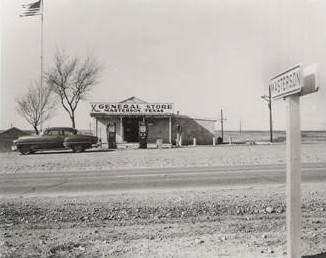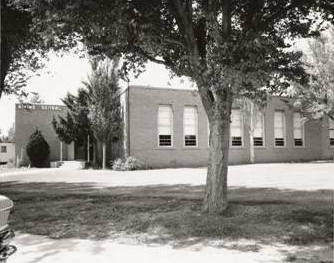|
 |
MASTERSON,
TEXAS
by Louise
George
In 1927 three companies combined their resources to
construct an industrial plant to produce and process natural gas from
the enormous reserves in the Hugoton Gas Field, which extends through
the Texas Panhandle,
the Oklahoma Panhandle and part of Kansas. The plant operated under
the name of Canadian River Gas and was located in Moore
County, Texas, thirty-two miles north of
Amarillo and sixteen
miles south of Dumas. Construction began
in late 1927 on the plant complex and a 342 mile pipeline to transport
natural gas to Denver, Colorado. At the same time, a hotel for single
workers and twelve houses for married workers and their families were
being built. The housing area was commonly known as a camp.
The plant was built on land purchased from Lee Bivins, member of a
prominent ranching family. The community would be named after him.
The plant was known as Bivins Compressor Station. On April 15, 1928
the Amarillo Sunday News carried an article with the headline:
GROWTH OF GAS INDUSTRY LEADS TO NEW TOWN
“BIVINS” SPRINGS UP IN SOUTH MOORE COUNTY
The article predicted grand things for Bivins; such as, a lake,
a swimming pool, a church and a school. Not all those predictions
came true. There was a church and a school, but there would be no
lake and no swimming pool. The last sentence in the story read: “The
town ‘Bivins’ will be on the map….” If Bivins was ever on the map,
it didn’t stay there for many years. |
After the houses
were occupied, the wife of a worker set up a classroom in her home
and taught the five children who lived in the camp. By 1930 there
were eighteen students and a one-room school was built. In 1937 the
plant expanded and an additional twenty homes were built. That year
a three-room brick school building was constructed at a cost of $14,485.
Early on, a Sunday school was organized and meetings were held in
the homes of its members. Later, classes were held in the schoolhouse.
From time to time over the years, there was not enough interest to
keep the church going. During those times folks who really wanted
to be in church drove to Dumas.
During the thirties, the demand for helium increased greatly when
the army and navy expanded their aviation programs. In June, 1941
the United States Department of the Interior requested a new facility
to meet the even greater demands for helium that would occur if the
United States became involved in World
War II. A survey across the southwestern region of the nation,
determined that natural gas with the highest content of helium was
to be found in the Panhandle field of Texas. In March 1942 a contract
was signed for land, located three-quarters of a mile west of Bivins,
for a helium plant to be constructed and operated by the U.S. Bureau
of Mines. The plant was hurriedly constructed and by March 1943, helium
was being produced by the Exell Helium Plant. Natural gas was delivered
to the plant from Bivins Compressor Station, the helium extracted
and the gas returned to Bivins. During the war, helium was used chiefly
in dirigibles that escorted ship convoys across both the Atlantic
and Pacific oceans to deliver troops and military equipment and supplies.
Later, helium was important to the space program.
Seventy-five homes were built adjacent to the helium plant and the
population of Masterson swelled to almost five hundred. The drastic
increase in school enrollment called for a larger building. Wartime
shortages, however, would delay any addition until 1946 when four
rooms were added. A few years later a gymnasium and cafeteria were
added.
First Baptist Church in Dumas organized
a mission in 1943 to serve the entire community. It was called Exell
Baptist Church and services were held in the school. In 1947, members
voted to borrow $2,000 for a cinderblock structure and they spent
their summer working on the church. The building had only an auditorium
with areas curtained off for Sunday school classes. Later, an old
barracks building was bought and moved in for classrooms.
When Bivins came into being, mail was carried by train from Amarillo
to Channing where a carrier picked
it up and delivered it to Bivins. Residents picked up their mail in
the office. Later, it would be carried by the bus that transported
employees who lived in Amarillo
to and from work. After the helium plant was built, the storekeeper,
who lived in Amarillo,
picked up mail there and delivered it to the plant. Camp residents
picked up their mail at a guard shack near the entrance to the plant.
In 1946, Steve Scott returned from a stint in the U.S. Army and went
to work in the office at Bivins Compressor Station. The next year,
he bought and moved an old barracks onto land he leased from Lee Bivins.
He established a combined grocery store and gas station and began
the tedious job of obtaining a post office. When that was done and
he met the qualifications for postmaster, he had to choose a name
for the town. To him, Bivins was the obvious choice, and that’s the
name he submitted to the Postal Service. The request was denied. Another
small town somewhere in the state was named Bivens. Next, he submitted
the name Levi. It was also rejected. There was already a Levi, Texas.
Robert B. Masterson was a prominent rancher in the area. Mr. Scott
submitted the name Masterson and the community finally had
an official name. Reta Horn would become postmaster soon thereafter,
and she held the position for more than thirty years.
After the town was named, the church also selected a new name – First
Baptist Church of Masterson. Though it was a Baptist church, it was
attended by members of all denominations. People who lived in two
other camps,
located outside the school district, came some distance to participate
in the church and its activities. The community also presented opportunities
for them to take part in 4-H, Boy Scouts, Girl Scouts, Home Demonstration,
youth and adult softball and various other social activities. |
 |
Beginning
in the forties and continuing for nearly twenty years, the school
averaged an enrollment of around a hundred students from first through
the eighth grade. At Bivins, scholastics were first priority and eighth
grade graduates were well prepared when they started school in Dumas.
Students scored well in interscholastic meets and in every year but
one from 1953 to 1970, Bivins had winners in either Junior or Senior,
or both, divisions of Moore County Spelling Bee. Over the years competition
in sports included baseball, volleyball and track, but basketball
was the most popular. Most residents were avid fans of the Bivins
Broncos and drove many miles to cheer them on when they played other
small schools in the area.
1963 was the beginning of the end. That spring, Bivins
camp residents were notified that all the houses in their camp
would be sold within the next two years. Reluctantly, families began
to move into new homes in Dumas or Amarillo.
A few months later the people at Exell got notice that houses vacated
in their camp
would be sold. Seeing the certain demise of the community, residents
of that camp
also began to move.
In the spring of 1966, the church had a special ceremony to burn the
note on the auditorium and parsonage built several years earlier.
In January of the following year, members voted to disband. There
were not enough members left to support the church.
Except for two houses at Exell, both camps
were gone by 1970. Still, the school struggled on for several years.
The majority of its few students came from Middlewell,
a farming community which had closed its school some years earlier.
With only four students scheduled to enroll for the school year ‘77-‘78,
trustees voted to close the school after the spring semester of 1977
and bus students to Dumas.
To serve the few remaining families in the area, the post office and
store remained open until 1984, when Mrs. Horn retired.
The federally operated Exell Helium plant fell victim to privatization
and was closed in the late 1990s. The plant’s buildings remain, but
all the equipment has been sold. Canadian River Gas sold the Bivins
plant to Colorado Interstate Gas Company in 1951. In 2002 Pioneer
Natural Resources bought them out and the plant continues to produce
and process natural gas. Artifacts from both plants are on display
at Window on the Plains Museum in Dumas.
Nowadays, the store and post office building are empty. The church
building is used for storage and a retired couple lives in the parsonage.
The school was sold to a Borger
church to use as a retreat. A Masterson reunion is held there every
other year.
© Louise
George |
1940s Moore
County Texas map showing "Bivins"
From Texas state map #4335
Courtesy
Texas General Land Office |
| Texas
Escapes, in its purpose to preserve historic, endangered and vanishing
Texas, asks that anyone wishing to share their local history, stories,
landmarks and recent or vintage photos, please contact
us. |
|
|
